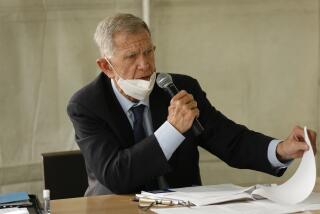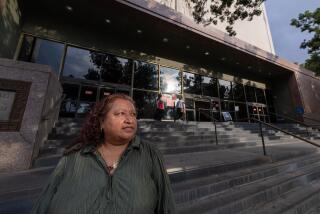For L.A. Dependency Court, a first: the press
- Share via
I have been attending trials in Los Angeles for 20 years. I’ve covered torture and murder, drug smuggling and bank robberies. I covered the trial of the officers who beat Rodney G. King and the rioters who beat Reginald O. Denny. I covered the murder trial of O.J. Simpsonand the child molestation investigation of Michael Jackson. I’ve been put on the stand and been told to reveal my sources for some unflattering documents regarding Police Chief Willie L. Williams (I refused). But one type of hearing has remained presumptively off-limits.
Until last week. On Wednesday morning, I took a seat in Courtroom 415 at the Los Angeles Dependency Court, where cases are heard involving child abuse and neglect. Judge Amy Pellman brought the room to order promptly at 9 a.m. and informed anyone who didn’t know already that I was there to observe for the day. She asked whether anyone objected to my staying. Boy, did they.
For years, advocates of greater transparency in the child welfare system have argued that public and press access to dependency courts would improve the public’s sense of how that system works. But the forces in favor of secrecy were strong – a combination of well-meaning defenders of children’s privacy and unions and legal organizations who want to shield social workers, lawyers and others from public scrutiny. Those forces had prevailed until this month. But then Michael Nash, the presiding judge of Los Angeles Juvenile Court, issued an order decreeing that dependency hearings, which had been presumptively closed, were now to be presumptively open to the press. As a member of the press, I went last week to take advantage of this new right.
The first objection was to my being present for a hearing over whether I could be present. Pellman ruled in my favor. Then lawyer Thomas Wayne Pichotta argued that Nash was wrong to issue his order and that Pellman should not open her courtroom until opponents could get a ruling on their appeal. Pellman rejected that argument, too. Pichotta then delivered a dissertation on the right of privacy, which he asserted was grounded in the 4th Amendment. Pellman rejected his objection.
Other lawyers then chimed in with their own protests. Some argued it should be my burden to show that my presence wouldn’t harm children. My lawyer (yes, I had a lawyer with me, since I’d expected objections) rebutted that. Another asked for a delay; Pellman said no.
The lawyers asked Pellman to order me not to divulge the names of children involved in these proceedings; she correctly conceded that she had no power to issue such an order, but I volunteered to withhold them, consistent with The Times’ general practice in this area.
There were more objections, but finally they were all dispensed with and the day began. What followed was tragic, enlightening and important for the public to know. A man struggled to persuade the court to look past his criminal history and return his daughter to his custody; a woman whose two girls had been taken away made a desperate plea to get them back before she loses them forever to adoption; a broken family asked the court for help in reuniting a group of sisters under one roof.
Pellman was alternately stern and forgiving. She reminded the mother trying to recover her children that she’d had chances to do so and had failed. Her time, the judge warned, was running out. “Childhood has a short shelf life,” Pellman said. “They deserve to have a mommy who’s stable.” The woman wept.
An essential goal of openness is to expose failings in the system, and those, too, were evident. One child takes medication for seizures that exacerbates behavior problems, and medication for behavior that aggravates the seizures. She needs – but has yet to receive – better coordinated care. Pellman expressed frustration that it took seven months for her to receive information on this case, and directed the child’s caregivers to work together.
That one was of several glimpses of the greater accountability that public access to these courts will help bring about, but there also were reminders that access will also deepen appreciation for the system. Pellman’s courtroom, decorated with teddy bears and a Spongebob Squarepants tapestry, is a place of both authority and compassion, and the lawyers who fought so hard to exclude me worked hard for their clients, all of whom ignored my presence.
In one instance, a young couple had lost their son to protective services but then completed the counseling required of them and applied for his return. “We have an excellent report from the social worker,” Pellman told the couple. “Congratulations, you’ve done very well.”
With that, she agreed to reunite parents and child. The boy, sitting behind me in the courtroom, called out “Mama” and reached for her as she left the room, her boy in her arms. “Spongebob,” he added, pointing at the tapestry.
Secrecy has hidden many sins in the Los Angeles County foster care system. The system has failed to take children from dangerous homes or placed them in unsafe situations, without any public scrutiny. Openness will help expose such problems. But secrecy also has cloaked the system’s successes; they, too, will be on display as this important experiment in open government unfolds.
Jim Newton’s column appears Mondays. His latest book is “Eisenhower: The White House Years.” Reach him at jim.newton@latimes.com or follow him on Twitter: @newton_jim.
More to Read
A cure for the common opinion
Get thought-provoking perspectives with our weekly newsletter.
You may occasionally receive promotional content from the Los Angeles Times.










